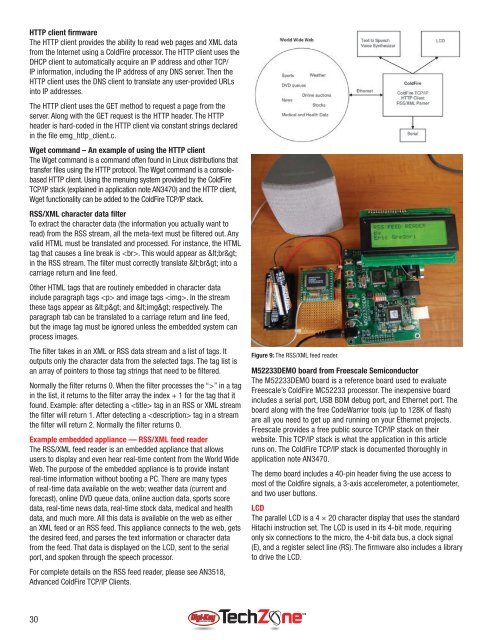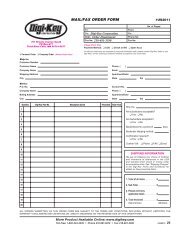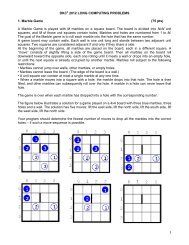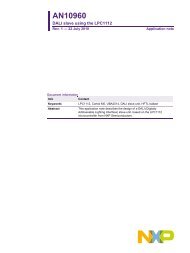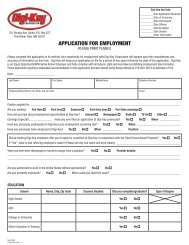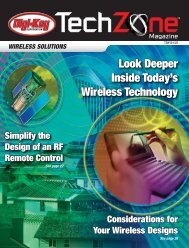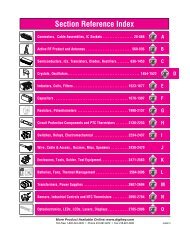Microcontroller Solutions TechZone Magazine, April 2011 - Digikey
Microcontroller Solutions TechZone Magazine, April 2011 - Digikey
Microcontroller Solutions TechZone Magazine, April 2011 - Digikey
You also want an ePaper? Increase the reach of your titles
YUMPU automatically turns print PDFs into web optimized ePapers that Google loves.
HTTP client firmware<br />
The HTTP client provides the ability to read web pages and XML data<br />
from the Internet using a ColdFire processor. The HTTP client uses the<br />
DHCP client to automatically acquire an IP address and other TCP/<br />
IP information, including the IP address of any DNS server. Then the<br />
HTTP client uses the DNS client to translate any user-provided URLs<br />
into IP addresses.<br />
The HTTP client uses the GET method to request a page from the<br />
server. Along with the GET request is the HTTP header. The HTTP<br />
header is hard-coded in the HTTP client via constant strings declared<br />
in the fi le emg_http_client.c.<br />
Wget command – An example of using the HTTP client<br />
The Wget command is a command often found in Linux distributions that<br />
transfer files using the HTTP protocol. The Wget command is a consolebased<br />
HTTP client. Using the menuing system provided by the ColdFire<br />
TCP/IP stack (explained in application note AN3470) and the HTTP client,<br />
Wget functionality can be added to the ColdFire TCP/IP stack.<br />
RSS/XML character data filter<br />
To extract the character data (the information you actually want to<br />
read) from the RSS stream, all the meta-text must be fi ltered out. Any<br />
valid HTML must be translated and processed. For instance, the HTML<br />
tag that causes a line break is . This would appear as <br><br />
in the RSS stream. The fi lter must correctly translate <br> into a<br />
carriage return and line feed.<br />
Other HTML tags that are routinely embedded in character data<br />
include paragraph tags and image tags . In the stream<br />
these tags appear as <p> and <img> respectively. The<br />
paragraph tab can be translated to a carriage return and line feed,<br />
but the image tag must be ignored unless the embedded system can<br />
process images.<br />
The fi lter takes in an XML or RSS data stream and a list of tags. It<br />
outputs only the character data from the selected tags. The tag list is<br />
an array of pointers to those tag strings that need to be fi ltered.<br />
Normally the fi lter returns 0. When the fi lter processes the “>” in a tag<br />
in the list, it returns to the fi lter array the index + 1 for the tag that it<br />
found. Example: after detecting a tag in an RSS or XML stream<br />
the fi lter will return 1. After detecting a tag in a stream<br />
the fi lter will return 2. Normally the fi lter returns 0.<br />
Example embedded appliance — RSS/XML feed reader<br />
The RSS/XML feed reader is an embedded appliance that allows<br />
users to display and even hear real-time content from the World Wide<br />
Web. The purpose of the embedded appliance is to provide instant<br />
real-time information without booting a PC. There are many types<br />
of real-time data available on the web; weather data (current and<br />
forecast), online DVD queue data, online auction data, sports score<br />
data, real-time news data, real-time stock data, medical and health<br />
data, and much more. All this data is available on the web as either<br />
an XML feed or an RSS feed. This appliance connects to the web, gets<br />
the desired feed, and parses the text information or character data<br />
from the feed. That data is displayed on the LCD, sent to the serial<br />
port, and spoken through the speech processor.<br />
For complete details on the RSS feed reader, please see AN3518,<br />
Advanced ColdFire TCP/IP Clients.<br />
Figure 9: The RSS/XML feed reader.<br />
M52233DEMO board from Freescale Semiconductor<br />
The M52233DEMO board is a reference board used to evaluate<br />
Freescale’s ColdFire MC52233 processor. The inexpensive board<br />
includes a serial port, USB BDM debug port, and Ethernet port. The<br />
board along with the free CodeWarrior tools (up to 128K of fl ash)<br />
are all you need to get up and running on your Ethernet projects.<br />
Freescale provides a free public source TCP/IP stack on their<br />
website. This TCP/IP stack is what the application in this article<br />
runs on. The ColdFire TCP/IP stack is documented thoroughly in<br />
application note AN3470.<br />
The demo board includes a 40-pin header fi ving the use access to<br />
most of the Coldfi re signals, a 3-axis accelerometer, a potentiometer,<br />
and two user buttons.<br />
LCD<br />
The parallel LCD is a 4 × 20 character display that uses the standard<br />
Hitachi instruction set. The LCD is used in its 4-bit mode, requiring<br />
only six connections to the micro, the 4-bit data bus, a clock signal<br />
(E), and a register select line (RS). The fi rmware also includes a library<br />
to drive the LCD.<br />
30


